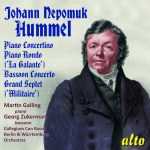|
Back
12/11/2022
Johann Nepomuk Hummel: Piano Concertino in G major, opus 73 [1] – Introduction and Rondeau for Piano “La Galante”, opus 120 [1, 4] – Bassoon Concerto in F major, S 63 WoO 23 [2, 4] – Grand Military Septet in C major, opus 114 [3]
Martin Galling [1], Helmuth Barth [3] (piano), George Zukerman [2] (bassoon), Johannes Brüning [3] (violin), Hannelore Michel [3] (cello), Georg Nothdorf [3] (double bass), Michael Achilles [3] (flute), Werner Diestel [3] (clarinet), Ingus Schmidt [3] (trumpet), Berlin Symphony Orchestra [1], Carl-August Bünte [1] (conductor), Württemberg Chamber Orchestra [4], Jörg Faerber [4] (conductor), Collegium Con Basso [3]
Recording: Vienna, Austria (1965/70) – 77’
Alto # ALC 1466 (Distributed by Naxos of America) – Booklet in English

   
Works by Johann Nepomuk Hummel frequently get overlooked and fall way under the radar; therefore, it’s a thrill when his music surfaces. Albeit, these recordings are a compendium of recordings reaching way back to 1965 and 1970, stereo has been discovered, along with remastering by Gene Gaudette and Paul Arden-Taylor. In a nutshell, the sound is quite spectacular.
Hummel, a child prodigy, was a pupil of Mozart, including that of Salieri and Clementi. He went on to become a virtuosic pianist, credited with creating numerous sonatas, concertos and assorted trios, quartets and quintets. But he also ventured into use of other woodwind and brass instruments, including trumpet and bassoon to create his own distinctive style. In this Alto release, we hear George Zukerman’s immaculate bassoon dexterity and Martin Galling’s effervescent mastery on piano.
Johann Nepomuk Hummel’s music is highly approachable and benevolent: nothing harsh and music that pleasingly resolves. The opening Piano Concertino in G major is housed in three movements. Hummel’s music has a very clean and dignified demeanor. M. Galling is a master of elegant control, suave and swift in the stately runs that Hummel presents on paper. Even though Hummel’s music is thought to infuse Beethoven, to this reviewer, the music reigns in more Schubert (ref: “Trout” Quintet) with M. Galling turning on Hummel’s amazingly delicate embellishments, particularly in the “Rondo” which even anticipate the complexities of Henri Herz. An impeccable delivery.
The ensuing Introduction and Rondeau has more gravity, though not any less attractive than the aforementioned. The opening “Introduzione” is fun, and it gives the artist broad brush strokes to tailor the precise amount of frivolity. It’s here that Martin Galling gives his own shadings...dramatically assertive in certain reaches with pockets of impish pauses. The “Rondo” contains lustrously delivered runs, giving the closing bars a spectacular finish. Wholly pure and enchanting.
Within the confines of the Bassoon Concerto we hear the smoky timbre of George Zukerman’s bassoon performance. What’s particularly intriguing is how, despite its weighty sound, the woodwind can produce a very light, soft and warm parlance. M. Zukerman achieves a sense of organic glow. Toward the end of the “Allegro moderato” the bassoon’s solo allows the listener to hear the key pads lightly tapping away as the fluidity of fast notes briskly moves forward. It gives a warm embrace. So, too, are the inescapable almost octave-like reaches that suddenly pop into the score. Tremendous in their reach, the transitions are neatly handled and without error. Hummel’s music draws the listener into an enchanting sound world for the entire duration. Unsullied.
Adding a nice contrast is the dignified Grand Military Septet with its handsome chatty dialogue that neatly moves between each of the seven instruments. Again, Hummel succeeds in creating a very dynamic and engaging piece. The œuvre presents itself with a very dignified character and simply weaves back and forth without any undue pressure or irritation. Ingus Schmidt, in particular, exercises attentive restraints during his trumpet enclaves. Similarly, Michael Achilles’ flute brackets the roof on higher notes while Werner Diestel’s clarinet gives the piece a bit of entertaining wheedling. Even though the third movement (ref: “Menuetto: Allegro”) commences with a tinge of severity, the remainder of the piece broadens into grand agreeability with a trumpet commentary (1’33) adding an almost modern “South of the Border” enchantment to the score. But it’s within the “Finale: Vivace” that we hear distant breaths of Schubert wafting in the air and wrapping up all the “loose conversations” into a final, grand close.
Though Mozart’s infusions exist, Johann Nepomuk Hummel’s music takes on a distinctive style with firm agreeability and jubilation. This is a CD you’ll not want to miss if you’re looking for music that bridges the gap between classical and the opening chapters of Romanticism. Purely polished and pristine! Highly recommended.
Christie Grimstad
|